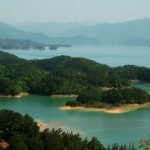Free Registration
About Zhejiang
Zhejiang Province is located in the south wing of the Yangtze River Delta on the southeast coast of China, bordering the East China Sea to the east, Fujian to the south, Jiangxi and Anhui to the west, and Shanghai and Jiangsu to the north. The Qiantang River, the largest river in the territory, is also called Zhejiang or Zhejiang because of its twists and turns, hence the name of the province. The provincial capital is Hangzhou.
With complex terrain, Zhejiang slopes from southwest to northeast, forming three roughly paralleled mountain ranges. The northwest range stretches from Huaiyu Mountain at the junction of Zhejiang and Jiangxi to Tianmu Mountain and Qianligang Mountain; the middle range extends from Xianxia Ridge at the junction of Zhejiang and Fujian to Siming Mountain, Kuaiji Mountain, Tiantai Mountain, and finally to the Zhoushan Islands in the sea; the southeast range extends from Donggong Mountain at the junction of Zhejiang and Fujian to Dayang Mountain, Kuocang Mountain and Yandang Mountain. The highest peak in Zhejiang is Huangmao Peak at 1929 meters above sea level in Longquan City.
The main water systems include the Qiantang River, Oujiang River, Lingjiang River, Tiaoxi River, Yongjiang River, Feiyun River, Aojiang River, Cao’e River and the Zhejiang Section of the Beijing-Hangzhou Grand Canal. The Qiantang River, the largest river in Zhejiang Province has two sources. The north source is 668 kilometres long from the source to the estuary into the sea, of which 425 kilometres is in Zhejiang Province; the south source is 612 kilometres from the source to the estuary into the sea, all in Zhejiang Province.
The lakes mainly include the West Lake in Hangzhou, the East Lake in Shaoxing, the South Lake in Jiaxing, the Dongqian Lake in Ningbo, and Qiandao Lake, the largest artificial lake in the province, formed after the completion of Xin’anjiang Hydropower Station. Topographically it can be roughly divided into six areas: the Northern Zhejiang Plain, the Western Zhejiang Hilly Area, the Eastern Zhejiang Hilly Area, the Central Jinqu Basin, the Southern Zhejiang Mountainous Area, and the Southeast Coastal Plain and the Coastal Islands.
As one of the smallest provinces in China, Zhejiang has a land area of 105,500 square kilometres, accounting for 1.1% of the country’s land area. The straight line distance between east and west is about 450 kilometres, so is that between north and south. Of the province’s land area, mountainous land accounts for 74.63%, water surface accounts for 5.05%, and flat land accounts for 20.32%.
With an ocean area of 260,000 square kilometres, Zhejiang has 2,878 islands whose area exceeds 500 square meters each, and 26 islands whose area exceeds 10 square kilometres, making it a province with the largest number of islands in the country. Among them, Zhoushan Island is the fourth largest island in China, with an area of 502.65 square kilometres. In the “2016 China Ocean Island List”, Zhejiang has 21 islands on the list, accounting for 1/5 of the total.

B2B Meeting:
We will hold a B2B meeting for suppliers and purchasers. If you have any purchasing plan, please don’t miss this free chance to find high-quality suppliers, And our virtual expo was organized by China Council For The Promotion of International Trade Zhejiang Provincial Committee. You will have a great experience during the expo. Also, by using our platform Fairsroom, you can communicate with suppliers face to face online. Come and join us. It’s just from 19-25 Oct.






























